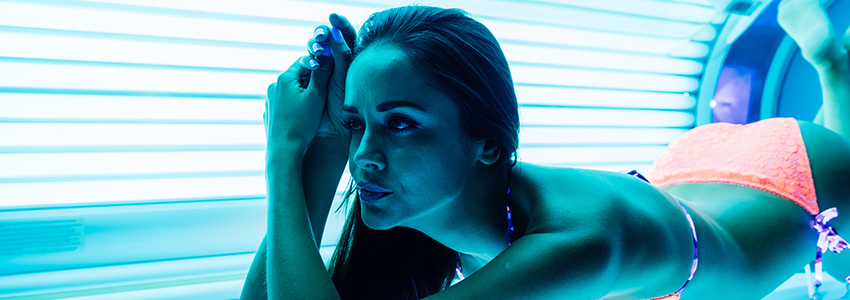
Indoor Tanning lotion draws the UV light into your skin for a deeper, darker, longer lasting tan. Indoor Tanning lotion increases your Melanin Production, which in turn tans you FASTER! When you tan you lose essential skin nurturing vitamins & minerals, most of our indoor tanning lotions replace what was lost. Hydrated skin not only holds color longer, but looks healthier. We offer many varieties to fit YOUR everyday needs. Keep in mind that it takes 7 minutes for UV light to penetrate dry skin that is not moisturized with an indoor tanning lotion. This means that you save time and money when you use the right stuff.
Outdoor sunscreens actually block UV development making each tanning session less effective. Additionally, oils damage the acrylic on beds. Our indoor tanning lotions are UV attractors increasing your tanning potential with every session. When using our indoor tanning products not only do you get ultimate color development, your skin is drenched with ultimate skin care.
Yes. You can burn in a sunbed just as you would burn in the sun. That is why we strongly recommend that all customers start off with short sessions, and gradually build up to the maximum amount of time.
Yes. Even with your eyes closed, your eyelid is not enough to protect your eyes from UV rays. Always wear protective eyewear when tanning indoors and outdoors.
Your face is the hardest part of your body to tan and it usually fades the quickest. Our facial tanners provide your face with more UVA rays to give it more deep color and hold its tan longer.
YES. It is very important that you have some type of lotion on your skin when you tan. Maintaining your skin’s moisture is vital to achieving a healthy tan. Without the use of a good lotion, you will run the risk of dry skin, premature aging, and your tan will fade very quickly. A good lotion will accelerate your skins ability to tan, moisturize your skin, help you produce more melanin, and help hold your tan much longer. It takes 7 minutes for UV light to penetrate dry skin that has no lotion on it.
Yes. Certain types of medications, mainly antibiotics, can increase your sensitivity to UV light. We always recommend that tanners consult their Pharmacist or Doctor if in doubt.
Depending on the type of lamp, our lamps are rated for 500-1000 hours of tanning life. We change our bulbs well in advance of the manufacturer’s recommendations.
NO! Heat has nothing to do with the way a bed tans. All of our tanning units are equipped with built in cooling fans. We are trying to keep the customers as cool as possible, unfortunately, after several uses throughout the day, the beds do become hot. However, never confuse heat with tanning power, heat just makes you temporarily red similar to that of a hot shower. It is not any part of the tanning process.
It is recommended that a person tans every other day for 4-7 tanning sessions to develop a base tan. Then it is recommended they tan once or twice per week to maintain it.
Yes. You can shower immediately after tanning. However, it is important that you apply a moisturizing lotion after showering to replenish all the moisture that you have lost from tanning and the HOT shower. After all, dry skin and flaking is what causes a tan to fade the fastest.
Sunlight is absolutely essential to all life on earth. There are various reasons, both biological and psychological, why exposure to light is desirable. In addition, many people believe they look better with a tan. Thus, having a tan may provide a psychological uplift for some.
The “tan”, or pigmentation process, occurs in the epidermis, the top skin layer. The epidermis replaces all its skin cells every 28-30 days. Cells in the inner portion of the top skin layer divide themselves, migrate to the surface, gradually die and slough off. Skin cells contain melanin, and as a result of UV exposure, rise to the surface and flake off. Therefore, a tan can be maintained only by repeated exposure to UV light.
It is difficult to make a simple comparison between the sun and modern indoor tanning equipment. Just as various kinds of indoor tanning lamps and equipment differ in spectral output and energy emitted, the sun’s strength is dependant on several factors as well, such as the time of day or year, the latitude, cloud cover, pollution and reflection. Consequently, there is no formula for relating indoor tanning exposure times to outdoor exposure times.
The UV rays emitted by indoor tanning lamps do not emit sufficient energy to penetrate past the skin layers. Thus, despite claims and rumors to the contrary, internal organs are not directly impacted by longer wave UV light.
There exists no known reason why contact lenses may not be worn while tanning indoors. When the eyes are kept closed and proper protective eyewear worn, UV light is blocked from penetrating the eye or lens. However, the heat generated by indoor tanning equipment could cause the eye to dry a bit thereby making the lens uncomfortable. Just as one should moisturize the skin after tanning, contact lens wearers may also use the eye drops recommended by his/her optometrist.
While some dermatologists may advocate total avoidance of all sun exposure, the media seems to quote only those who do. Many dermatologists and others from the medical community have acknowledged the need for moderate sun exposure, while advocating the use of sunscreens.
There are several reasons why white spots become noticeable on the body once the tanning process begins. Patches of skin which do not tan could be the result of genetic determination. The melanocytes in that certain area may simply not be efficient at producing melanin. White spots could also appear due to the presence of a fungus which lives on the skin’s surface. While the fungus is harmless, it does absorb UV light which would normally penetrate the skin. This fungus did not appear as a result of tanning; it merely becomes noticeable once tanning occurs. It can be remedied through the use of prescription drugs or an over the counter extra strength dandruff shampoo is very effective at removing these white spots over time.
Itching and/or rashes may be linked to several unrelated causes, so it is important to obtain a tanning history on each customer. Some people are naturally photosensitive upon exposure to UV. Others are susceptible to heat rashes, a cause totally unrelated to UV light. Certain chemicals or ingredients found in cosmetics, lotions, shampoos and even the acrylic cleaner may cause itching as well. Rashes caused by these products generally occur in localized areas on which the products were applied. Customers should be advised to tan with the skin as clean as possible. If discontinued use of a suspected product does not inhibit the rash, a person should discontinue any exposure to UV light until the condition subsides or see a physician.
Phototherapy (or use of UV Light) has been effective in easing the skin problems common to this condition. There an also many drugs, including tetracycline and Retin-A, which are also widely used for treatment of acne. Because these drugs can render the skin photosensitive, one must avoid UV exposure when medicated. Furthermore the use of UV light for acne treatment should only be administered by a qualified Physician.
There is no conclusive evidence which substantiates that malignant melanoma is caused by gradual, moderate UV exposure. However, those who are predisposed to develop melanoma due to hereditary factors may intensify this condition with exposure to Indoor UV. While some studies have suggested a link between severe sunburn and malignant melanoma, there are other studies available that prove an inverse relationship. In a study published In the International Journal of Cancer in 1989 (known as the Western Canada Melanoma Study), Canadian researchers found a significant inverse association between melanoma and chronic or long-term occupational sun exposure in men, with the lowest risk in those with maximum occupational exposure. This may suggest that repeated exposure can be protective. Gradual, moderate exposure is not believed to be a strong influential factor as melanoma generally develops on those areas not normally exposed to UV light.
There exists a growing body of scientific evidence which indicates that same people actual require more light exposure in order to function properly. Exposure to bright light, such as that emitted by the mid-day summer sun, causes the brain to suppress the release of the hormone melatonin. Melatonin acts as a depressant in the body if generated during the daytime. Thus, when affected people are exposed to longer hours of bright light, they feel happier, euphoric and more able to enjoy life. Bright light sources emitting one visible light are now frequently used to successfully treat Seasonal Affective Disorder (SAD) and Sub-syndromal Seasonal Affective Disorder.
One may not make medical claims about indoor tanning equipment. However, phototherapy (or UV light treatment) can be used to ease the symptoms of psoriasis. The treatment is rendered by a trained physician with equipment specifically designed for such a purpose. Many salon operators report that customers who suffer mild forms of psoriasis improve after indoor tanning, and many psoriatics do purchase indoor tanning beds.
It is a point in the tanning process where no appreciable gains are being made, regardless of session frequency and/or duration.
It occurs when the tanning equipment you are currently using is no longer capable of elevating the tanning process beyond a given level.
It’s a phenomenon that occurs when a more powerful combination of UVA/UVB is introduced to the tanning process. This “triggers” the reserves of melanin (pigment in skin responsible for producing a tan) thereby greatly enhancing the overall tanning process.
There is no scientific and/or biological reason why a pregnant woman cannot tan indoors or outdoors. In fact, some researchers believe the productions of vitamin D caused by exposure to UVB may be beneficial to both the mother and fetus. However, there is some concern that the heat build-up which inevitably occurs when tanning indoors and outdoors may adversely affect some pregnant women, just as a sauna or Jacuzzi might. A pregnant woman may not be comfortable in the tanning equipment. Furthermore, for liability reasons, it is recommended that pregnant women consult their physician before tanning indoors or outdoors.

